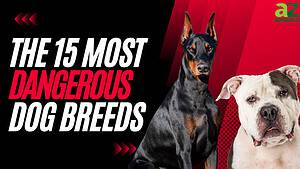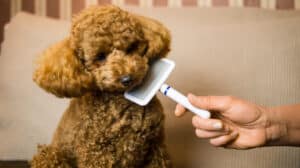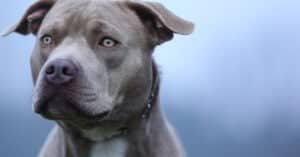Preparing to bring home an English bulldog puppy and wondering what you need to know about growth and development, feeding, training, and creating a lasting bond? Our guide has you covered on English bulldog progression.
Read on to learn more!
English Bulldog: Breed Summary
The history of the English bulldog covers many centuries, with historians of the breed estimating that their origin traces back to the early 13th century. Some researchers, like author William Lawlor, place the creation of the English bulldog to the year 1210, coinciding with the 1st official bullbaiting event in England. Bullbaiting was the horrific and torturous sport of forcing dogs, such as the English bulldog, to antagonize trapped bulls in pits until the terrified animal fought back against the dog. Both dog and bull were frequently mauled and killed in this cruel “sport”.
After many centuries of this horrific event, bullbaiting was officially banned in England following the passing of the Cruelty to Animals Act of 1835. In 1859, people began showing this breed in formal dog shows, and some historians believe this saved the English bulldog from extinction following the banning of bullbaiting. In 1875, supporters of the breed formed the Bulldog Club of England and created the first official English bulldog standard. Around this time, breeders began selecting dogs with gentle temperaments to help them transition to life as family dogs.
Attributes and Some Breed Standards
Today, despite their past of forced ferocity, bulldogs are known for their loving, silly, and gentle personalities. Many guardians of this breed find them to be confident (not as prone to anxiety or fear-reactivity) but also quite docile.
Of course, the breed of your dog doesn’t guarantee your pup will have any given traits, but studies demonstrate that genetics do have some effect in determining personality and other characteristics.
According to the AKC, the English bulldog “must be of medium size and smooth coat; with heavy, thick-set, low-swung body, massive short-faced head, wide shoulders, and sturdy limbs”.
You should recognize an English bulldog by their massive, square jaws that feature an underbite, with the lower jaw outlined on either side by deep, fleshy folds. The AKC accepted coat colors are red, fawn (tan-yellow), fallow (pale brown), white, or any of these in combination.
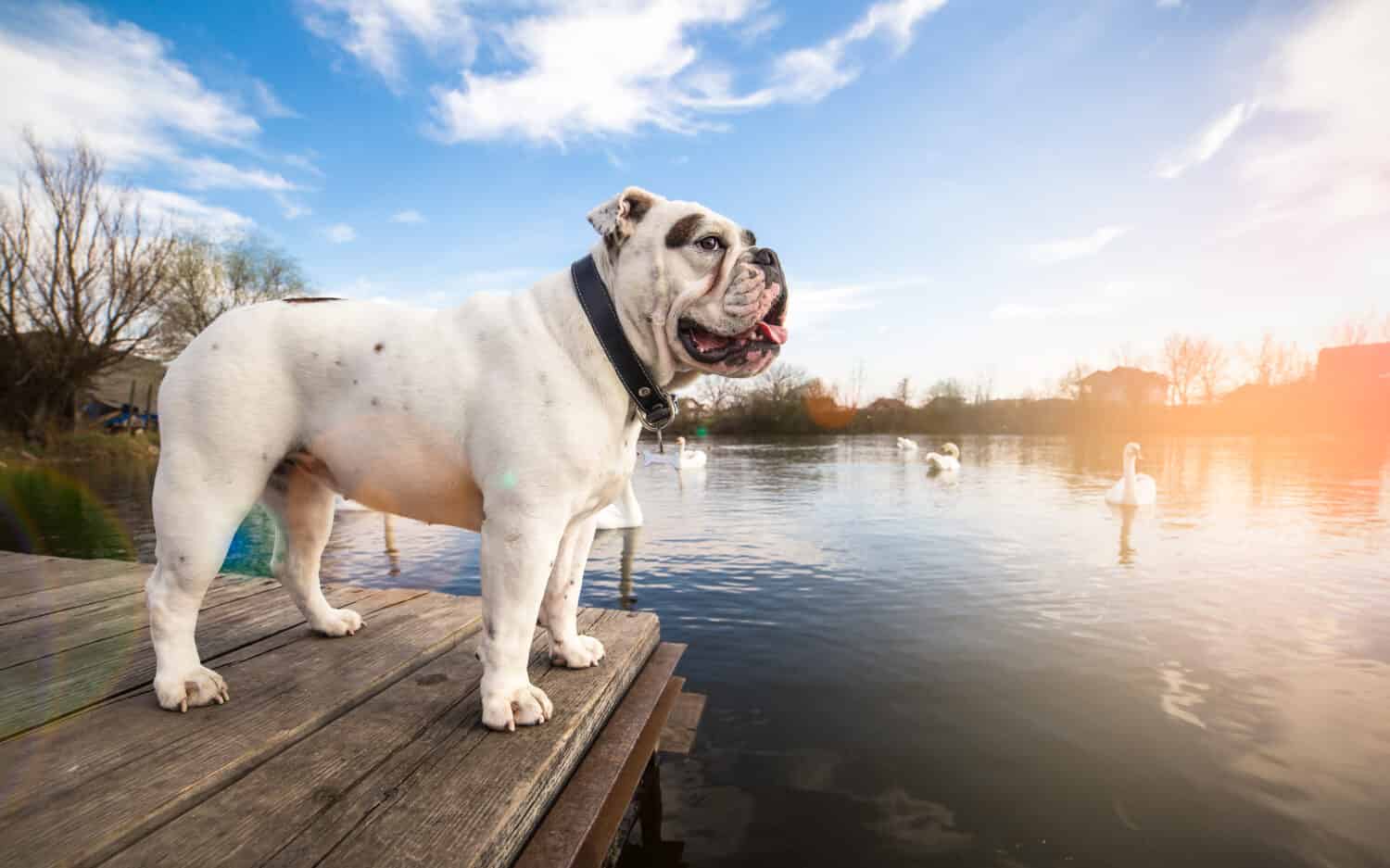
A mostly white English bulldog with a typical square body, underbite, and large jaws.
©Lunja/Shutterstock.com
English Bulldog Progression: Growth Chart
Check out our chart below to learn the average expected weight range for developing male and female English bulldogs.
| Age | Male Weight | Female Weight |
|---|---|---|
| 2 Months | 8-12 pounds | 7-11 pounds |
| 3 Months | 13-17 pounds | 12-16 pounds |
| 4 Months | 19-23 pounds | 18-22 pounds |
| 5 Months | 27-30 pounds | 23-28 pounds |
| 6 Months | 32-35 pounds | 26-31 pounds |
| 7 Months | 36-40 pounds | 30-33 pounds |
| 8 Months | 41-45 pounds | 33-36 pounds |
| 9 Months | 43-48 pounds | 35-38 pounds |
| 10 Months | 44-49 pounds | 36-39 pounds |
| 11 Months | 46-50 pounds | 37-41 pounds |
| 12 Months | 50-52 pounds | 40-41 pounds |
| 18 Months | 50-54 pounds | 40-43 pounds |
| 2 years | 50-55 pounds | 40-45 pounds |
When Will My English Bulldog Stop Growing?
Typically, your English bulldog pup will reach their max height at about 1 year old. Then, they should continue to fill out in girth and weight until they’re about 2 years old. Always provide your pup with fresh water, and try to feed them 3-4 times daily until they’re 6-8 months old. If you can’t provide multiple meals per day, just make sure you provide the appropriate caloric intake of puppy food twice per day.
If you want to ensure that your English bulldog puppy is on track developmentally, it’s always a great idea to take them to your vet for milestone checkups at 2-month, 3-month, 6-month, 9-month, and 1-year-old marks.
English Bulldog Progression: How Big Will My English Bulldog Be When Fully Grown?
When fully grown, you can expect a male English bulldog to weigh between 50-55 pounds and stand 14-15 inches tall at the withers. For adult females, expect them to reach 40-45 pounds, also standing 14-15 inches tall at the withers. Of course, this is an average, so you can expect diet and genetics to contribute to some variation.
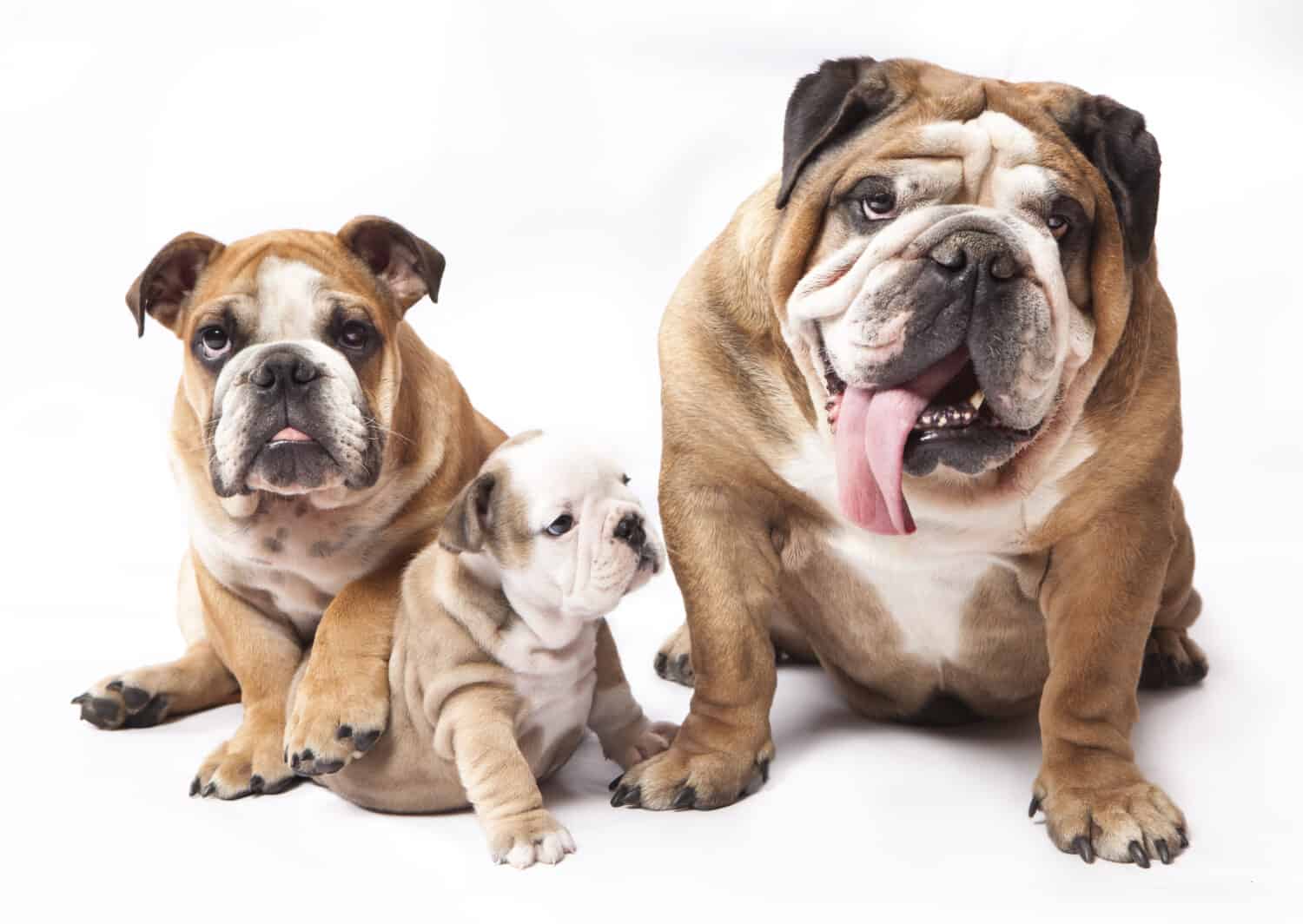
You can expect your English bulldog puppy to reach their full height at 1 year and full girth at 2 years old.
©Liliya Kulianionak/Shutterstock.com
When Should My English Bulldog Be Spayed or Neutered?
The issue of spaying and neutering is complicated due to a growing body of research that strongly demonstrates potential links between altering some breeds of dogs and the increased risk of certain cancers and long-term health issues. These studies have become more prominent in recent years, adding to older evidence supporting that spaying and neutering can decrease the risk of dogs developing certain cancers of the reproductive systems.
For English bulldogs, especially females, the benefit of preventing litters may outweigh the risks associated with spaying and neutering. English bulldogs, along with similar breeds such as French bulldogs, are anatomically designed so that giving birth naturally is incredibly dangerous. Compared to the narrow pelvis of the mother, the disproportionately large head and shoulders of the unborn puppies often cause major and life-threatening birthing complications. Over 90% of English bulldogs must undergo c-sections to prevent these complications. Of course, undergoing a C-section also comes with increased risks. Indeed, conversations exist within the animal welfare realm that justifiably questions the ethics of breeding dogs that can’t safely give birth naturally.
The general recommendation for this breed is to wait until your English bulldog is between 12-18 months old before spaying or neutering.
English Bulldog Progression: When Should My English Bulldog Be Potty Trained?
You can begin to housetrain your English bulldog pup when they are 8 weeks old. It’s important to know that puppies can generally only hold their bowels for as many hours as they are months old. So you’re 8-week-old puppy can likely only hold their bowels for up to 2 hours at a time. At night time, you can put puppy pads in their pen. During the daytime, if you want to transition your pup to going outside, you’ll need to take them out 15-30 minutes before they hit this 2-hour mark.
You can bring soiled puppy pads outside where you want them to go, so they can make smell associations of where to go. Some people also spray attractant pheromones outside in the areas where they want their pup to use the bathroom. With consistency and lots of positive reinforcement, you should be well on your way to your pup, understanding that potty time happens outdoors.
If your English bulldog pup has an accident indoors, it’s imperative never to punish them. By doing this, you’re only making them fear you and are teaching them that they aren’t safe to go to the bathroom around you. The result of this punishment can be that you damage your relationship with your pup and that they may start hiding where they go to the bathroom indoors. Instead, if they have an accident, remain totally neutral and simply take them outside. If they go outside, throw them a praise party, play a game with a favorite toy, bestow lots of treats upon them, etc.
When Should My English Bulldog Stop Eating Puppy Food?
At 12-16 months of age, you can transition your English bulldog from puppy food to adult food. You don’t want to make this transition too soon, as puppy food is formulated to support the developmental needs of your pup. If you switch to adult food too soon, you can negatively impact their growth and development.
At the point of transitioning, if you were feeding 3-4 times per day, you can start feeding only in the morning and evening. However, you can also continue to feed lunch if you desire as long as the calories are correctly calculated. Some folks like to make lunch part of their dog’s daily enrichment by feeding in a toy like a kong.
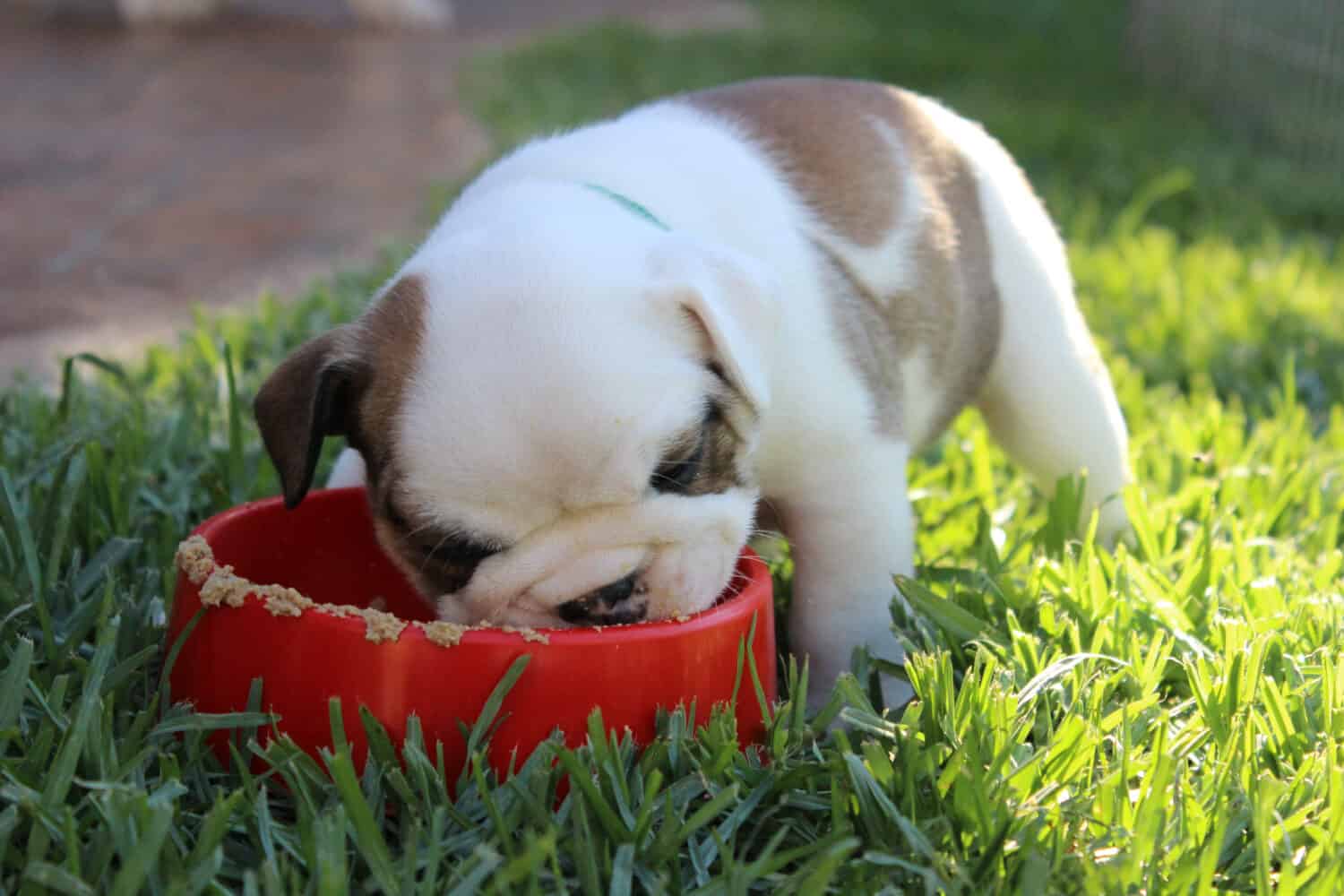
Continue feeding your
English bulldog puppy food
until they are 12-16 months old.
©AshMoss/Shutterstock.com
English Bulldog Progression: When Will My English Bulldog Start Losing Teeth?
Your English bulldog puppy will start to lose their set of 28 baby teeth at about the 12 to 16-week mark. As they lose these baby teeth, a set of 42 permanent teeth will come in. You can expect your English bulldog pup to have its full set of adult teeth at about 6 months old.
During this process, your pup will look for items to chew on to relieve discomfort. Make sure to have plenty of safe chewing items of various textures around the house. If you find that your puppy is chewing on inappropriate items, just calmly trade them for the item you do want them to chew on.
This is a great opportunity to teach them the “drop it” cue. To do this, simply offer them a chew toy or chewy treat that is more enticing than what they are currently chewing on. When you offer, the trade and your pup begins to drop the item to accept what you are giving, then say “drop it” in a calm, pleasant voice. Then say “Good!” or “Yes!” and hand your pup the appropriate chewing item. Make sure to continue trading, rather than only taking away items from your pup, so they don’t start developing resource-guarding tendencies toward you.
If you consistently only take away things from your pup, your pup will learn that you aren’t safe to have their precious items around. At this point, they can begin developing defensive behaviors around you, hide when they want to chew on something, or even eat dangerous items, fearing that you will take them away. So, prevent all of these fallouts by consistently offering trades.
When Should I Start Training My English Bulldog?
You can start teaching your English bulldog crucial life skills for navigating a human-oriented world when they are 8 weeks old. These skills aren’t about obedience or creating a dog that acts like a robot. Instead, they are about helping your dog stay safe, healthy, and happy in a world that can be quite hostile to their natural, normal behaviors like barking, chewing, digging, and walking in zig zags rather than straight lines.
.
Setting a happy, fun foundation for learning with your pup is imperative. Ethical training requires that your English bulldog puppy is excited to learn because you are developing a great bond and offer excellent, positive reinforcers during learning sessions. These reinforcers will help motivate your pup to repeat desired behaviors. As you learn about your pup, you’ll learn what they find the most motivating. This might be food, playing with you, playing with toys, etc. Just make sure you don’t offer these things only for training. It’s important to also freely offer affection, comfort, toy, play, and yummy treats as part of building, strengthening, and maintaining a healthy, secure attachment bond.
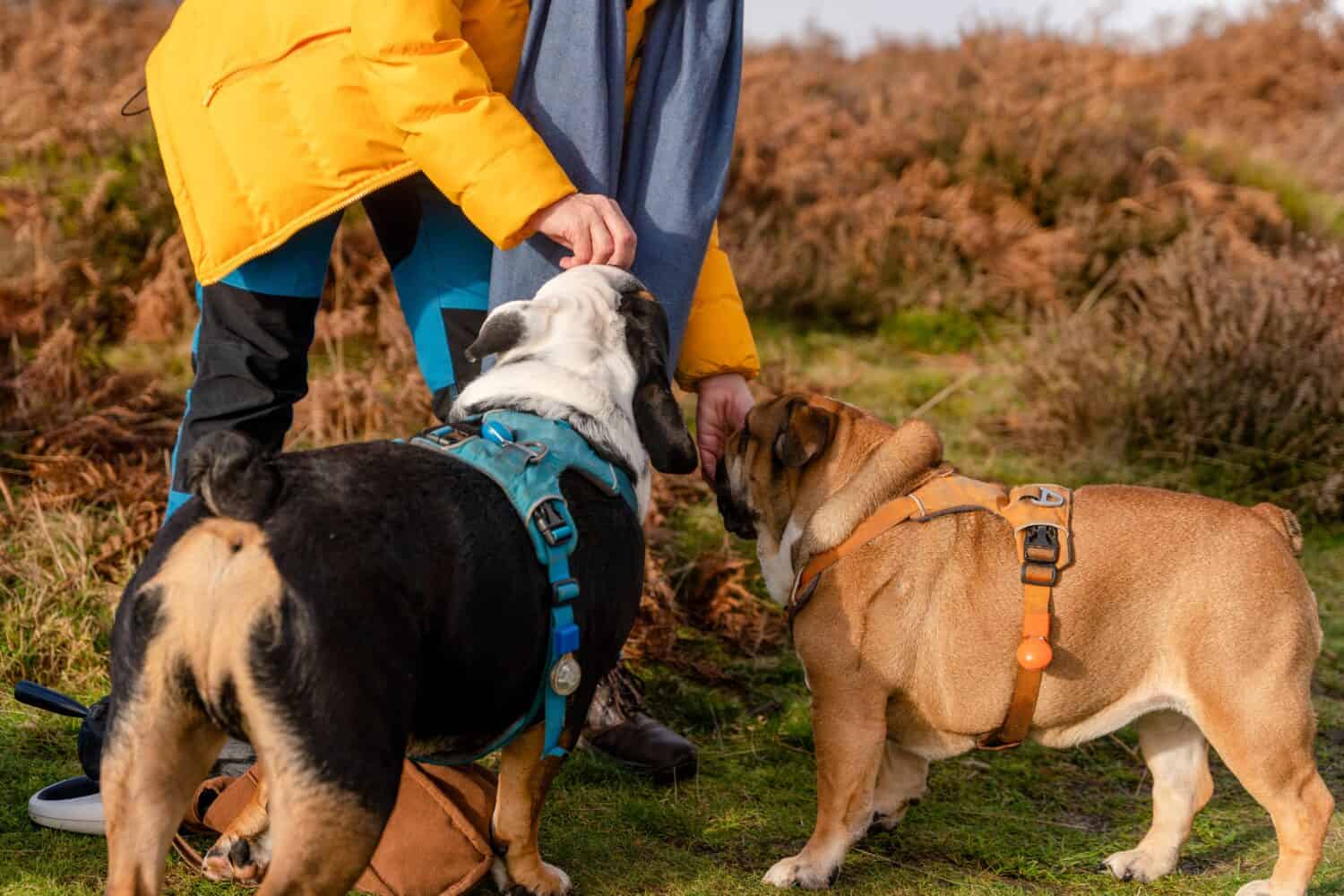
Reinforce behaviors you want to see with treats throughout your English bulldog’s life.
©Irene Miller/Shutterstock.com
What Cues Should I Teach My English Bulldog First?
When they reach adulthood, your English bulldog will be quite strong. So, it’s important to set a good foundation of polite leash skills when they are young. It’s simply not natural for dogs to walk in straight lines on leashes at a slower pace than humans. Instead, it’s much more natural for them to zig-zag around at various paces, sniffing and processing the world around them as they go.
When we seek to develop polite, loose leash skills with our pups, we ask them to do something unnatural for them. So, we must provide consistent, high-value reinforcers in exchange for them walking next to us or walking ahead without pulling us down the street.
And by the way, It’s totally fine for your pup to walk ahead of you, and anyone telling you differently is practising outdated and unethical dominance training. The goal here is to help your pup not pull, but walking ahead while not pulling on a long line can be a great way for them to have more freedom on their walk. Your pup isn’t trying to dominate you. They just want to live their doggie lives, communicate their needs, feel safe, seek connection, and express natural behaviors!
Loose Leash Walking
To practice your pup walking ahead without pulling, let them walk ahead, and then before they hit the end of a long lead, make a noise to get their attention (like a kissy noise), and then the very second they stop to look at you, say “good!” or “yes!” and quickly give them a treat. Repeat this several times in a short session. Your puppy will start to learn that pausing to look back and check in with you before they hit the end of the lead equals tasty treats.
In addition to walking ahead without pulling, teaching your pup to walk next to you can be really helpful when navigating crowded or chaotic environments. To do this the most effectively, you’ll want to wear a pouch on you to dispense small, high-value treats quickly. As you are starting out with your puppy, only train for a few minutes a day.
How to Practice
To practice walking next to you on the leash, hold the leash in one hand and a treat in the other. As you walk with your English bulldog puppy, immediately give them the treat while they walk beside you. You’ll want them to see that you have the treat, so they are excited to stay next to you.
Within three steps, you should be dispensing the next treat. This rapid reinforcement is very important for developing this skill. Eventually, you won’t have to dispense treats every few steps. However, you should continue to positively reinforce all the cues you ask of your dog throughout their lifetime. If you don’t, those skills will likely fade. This is especially true for the ones that aren’t natural for our dogs to perform, such as walking beside us in a straight line.
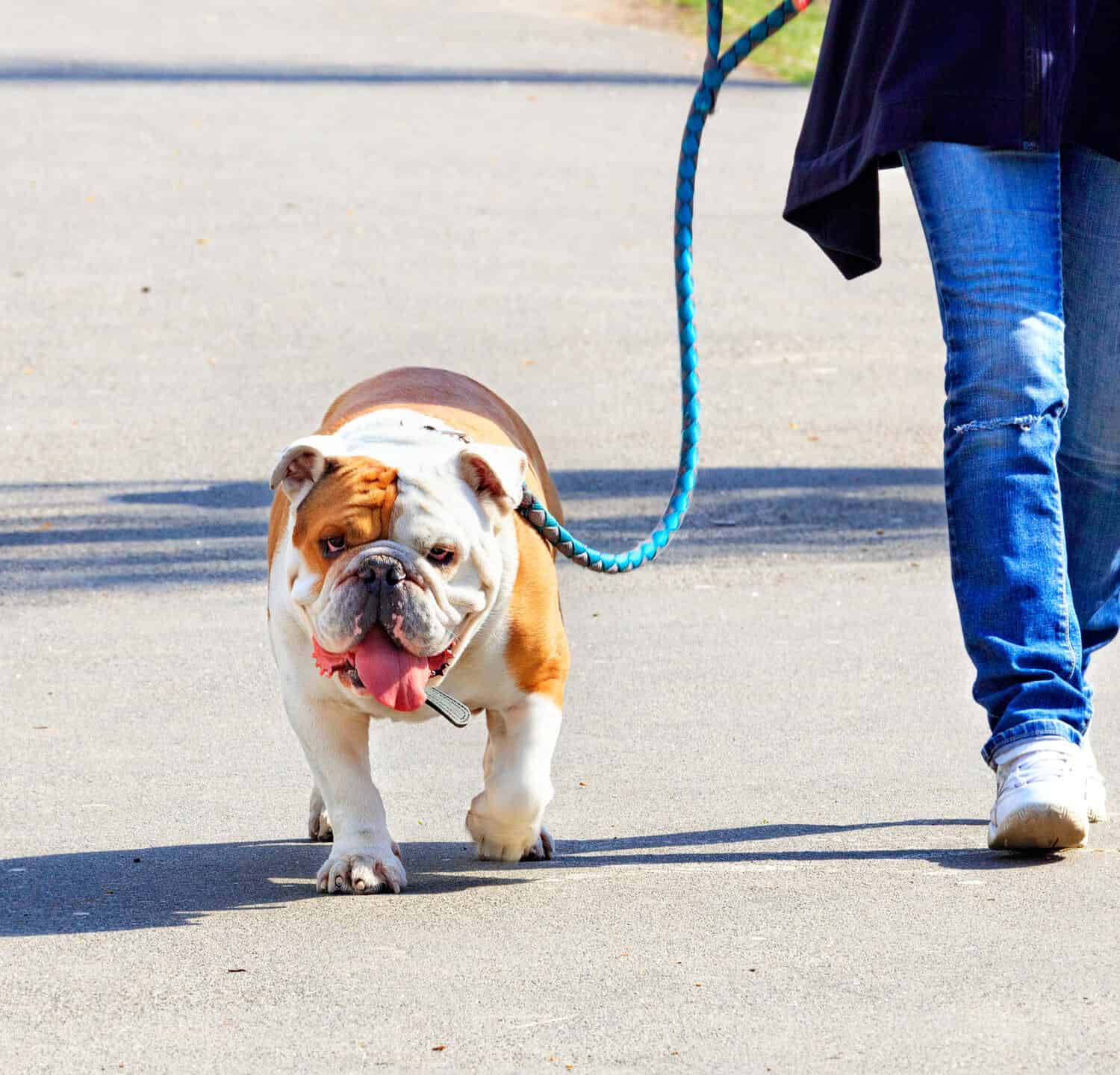
With positive reinforcement, you can teach your English bulldog to walk politely on a loose leash.
©Sergii_Petruk/Shutterstock.com
English Bulldog Progression: When Will My English Bulldog Calm Down?
While your English bulldog will likely be fully grown and filled out by 2 years old, they will continue to develop socially until 3-4 years of age. Around 4 years old, you will likely see your pup calm down a bit. However, if their needs are not being met for mental and physical enrichment and social connection, you can see various behavioral symptoms. This includes hyperactivity, anxiety, destructiveness, and restlessness. So, ensure you’re providing for your pup’s needs before expecting them to simply be calm.
Common Health Issues Your English Bulldog Might Experience
In recent years, those concerned with the welfare of dogs have been pushing important conversations around the ethics of breeding dogs who can’t give birth naturally and who are being bred to have faces that make it difficult for them to breathe.
Short-muzzled dogs are called brachycephalic. Unfortunately, many people tend to seek out the look of the cute, “smush-faced”, brachycephalic dog. So some breeders continually select for shorter and shorter muzzles and more compressed skulls. The result is a long-term health condition called brachycephalic airway obstructive syndrome. Additionally, the facial skin folds that English bulldogs are famous for also put them at risk of developing skin fold dermatitis. These are only some of the health issues that can innately develop from the features of English bulldogs. The more exaggerated features breeders select, the worse health outcomes the dogs endure. Concerned, expert institutions like the Royal Veterinary College are urging action to reduce these health issues and improve the welfare of purebred English bulldogs.
When considering bringing a puppy home, it’s always an excellent idea to think about all the puppies in shelters waiting for adoption. If you live in the US, you can choose from thousands of puppies as young as 8 weeks old that are in need of loving homes. Some of them are purebred English bulldogs, while others are mixed with this breed. If your heart is set on bringing home an English bulldog, please consider looking into rescuing rather than purchasing from a breeder.
Picture of English Bulldog Puppy
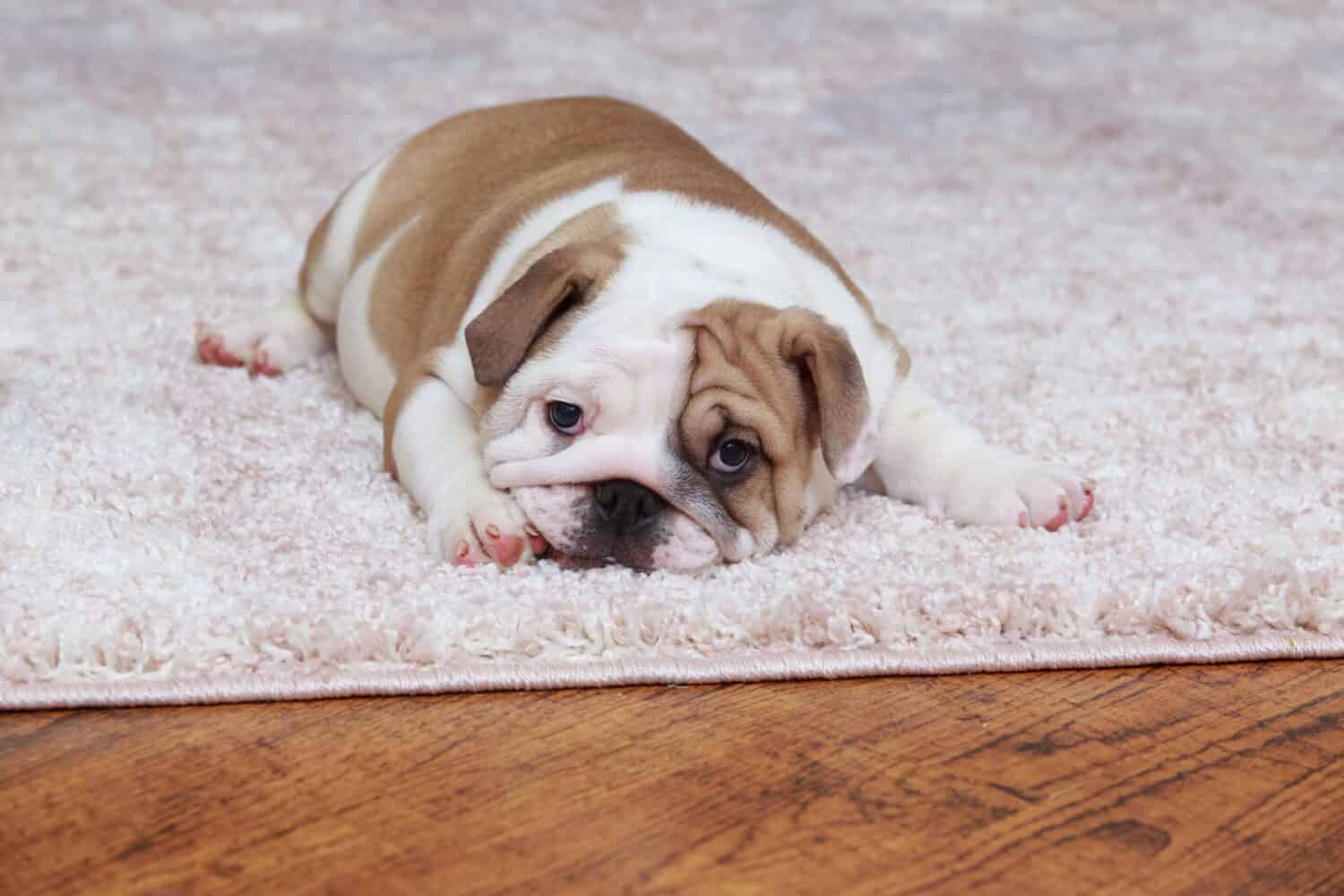
Adorable English bulldog puppy.
©Olga Aniven/Shutterstock.com
Picture of English Bulldog at 6 Months Old
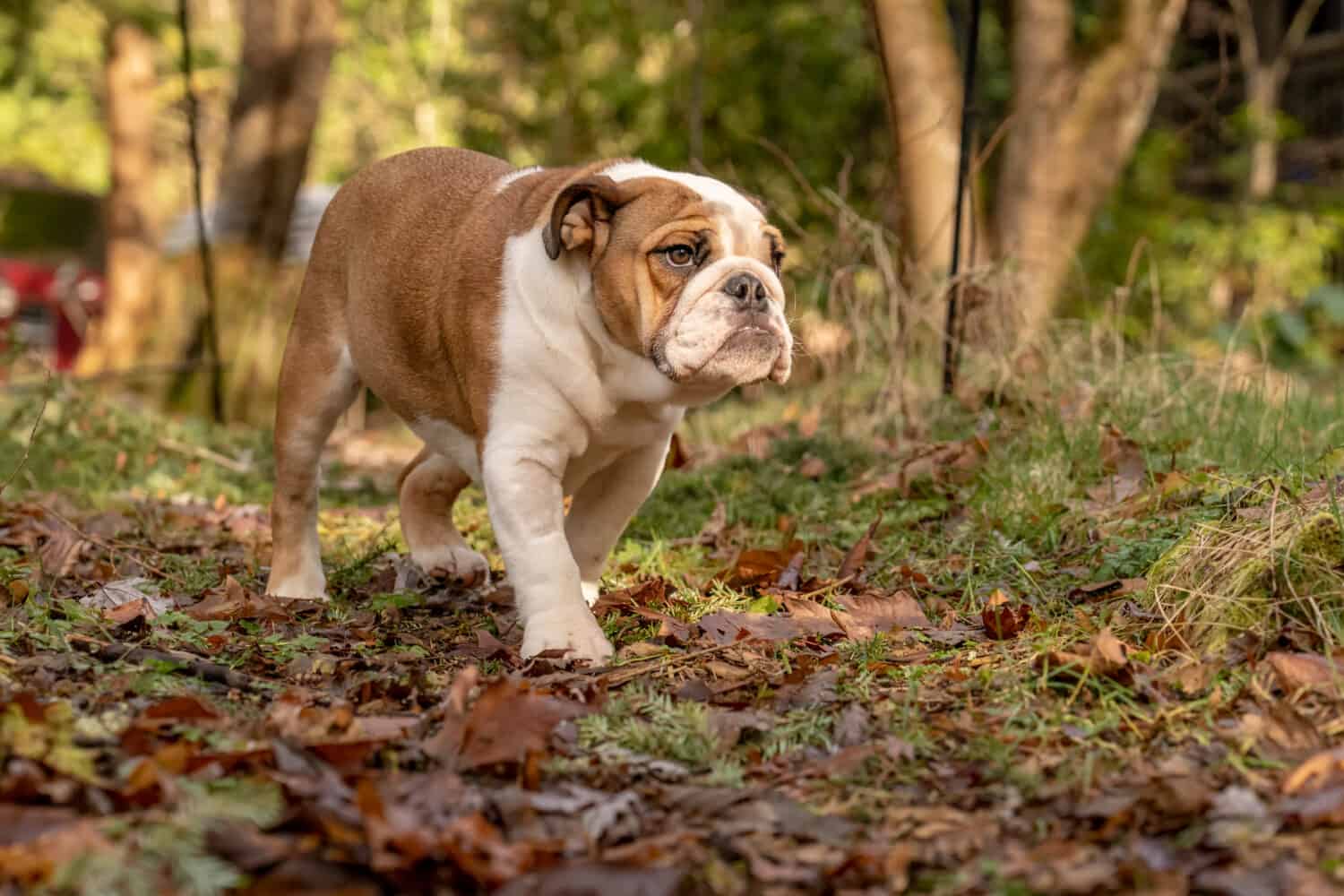
Sweet 6-month-old English bulldog.
©Danita Delimont/Shutterstock.com
Picture of an Adult English Bulldog
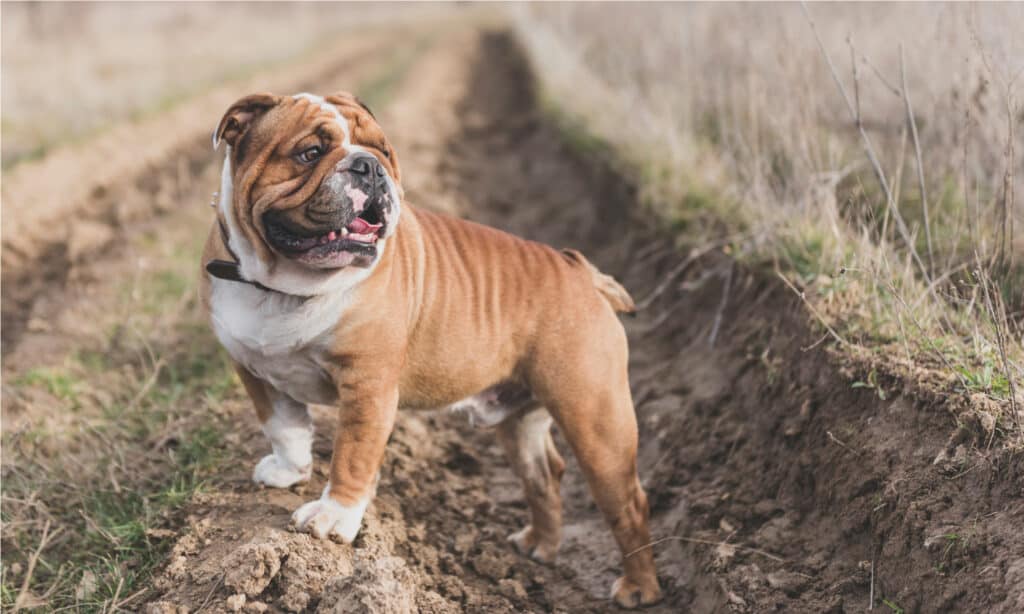
An adult English bulldog.
©ltummy/Shutterstock.com
The photo featured at the top of this post is © Ammit Jack/Shutterstock.com
Ready to discover the top 10 cutest dog breeds in the entire world?
How about the fastest dogs, the largest dogs and those that are -- quite frankly -- just the kindest dogs on the planet? Each day, AZ Animals sends out lists just like this to our thousands of email subscribers. And the best part? It's FREE. Join today by entering your email below.
Thank you for reading! Have some feedback for us? Contact the AZ Animals editorial team.



